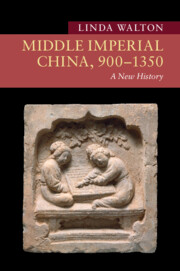Book contents
- Middle Imperial China, 900–1350
- New Approaches to Asian History
- Middle Imperial China, 900–1350
- Copyright page
- Dedication
- Contents
- Figures
- Maps
- Acknowledgments
- Introduction
- 1 The Turbulent Tenth Century
- 2 Song in a Multipolar World
- 3 Schooling, State, and Society in Song and Jin
- 4 An Economic Revolution?
- 5 Cities and Urban Life
- 6 Religious Transformations
- 7 Ways of Knowing
- 8 The Arts of Culture
- 9 Gendered and Generational Lives
- 10 Mapping the Built and Natural Environment
- 11 Sustaining Life and Healing Bodies
- 12 The Mongol Yuan Dynasty in China
- 13 Yuan China in the Mongol Eurasian Empire
- Bibliography
- Index
- New Approaches to Asian History
4 - An Economic Revolution?
Published online by Cambridge University Press: 20 July 2023
- Middle Imperial China, 900–1350
- New Approaches to Asian History
- Middle Imperial China, 900–1350
- Copyright page
- Dedication
- Contents
- Figures
- Maps
- Acknowledgments
- Introduction
- 1 The Turbulent Tenth Century
- 2 Song in a Multipolar World
- 3 Schooling, State, and Society in Song and Jin
- 4 An Economic Revolution?
- 5 Cities and Urban Life
- 6 Religious Transformations
- 7 Ways of Knowing
- 8 The Arts of Culture
- 9 Gendered and Generational Lives
- 10 Mapping the Built and Natural Environment
- 11 Sustaining Life and Healing Bodies
- 12 The Mongol Yuan Dynasty in China
- 13 Yuan China in the Mongol Eurasian Empire
- Bibliography
- Index
- New Approaches to Asian History
Summary
The idea that the Song experienced an economic (or monetary, financial, commercial) “revolution” has gained broad currency in the historiography. One key development was the monetization of the economy, including the introduction of paper currency, used along with various kinds of metal currencies for all kinds of commercial transactions and even tax payments. The role of the state was crucial, both in providing infrastructure for transportation and distribution networks and in implementing policies that supported merchant entrepreneurs and promoted the development of agriculture through the introduction of new technologies and new crops. Farmers specialized in the production of certain commodities, and ceramics, textiles, and other goods were also produced for the marketplace. Both urban and rural markets proliferated, and new kinds of merchant enterprises accompanied this commercial growth. The expansion of shipbuilding and advances in both shipbuilding and navigational technology supported the growth of maritime trade. Commercial relations with Japan and Korea in particular also fostered cultural connections: the transmission of religion, books, and other cultural commodities went along with silks, foodstuffs, metals, and aromatics. Despite ongoing political and military conflicts between them, overland border trade continued between Song and its northern nomadic neighbors to supply essential and luxury goods.
Keywords
- Type
- Chapter
- Information
- Middle Imperial China, 900–1350A New History, pp. 91 - 119Publisher: Cambridge University PressPrint publication year: 2023

